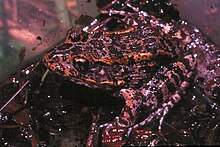Gopher frog
| Gopher frog | |
|---|---|

| |
| Scientific classification | |
| Kingdom: | Animalia |
| Phylum: | Chordata |
| Class: | Amphibia |
| Order: | Anura |
| Family: | Ranidae |
| Genus: | Lithobates |
| Species: | L. capito
|
| Binomial name | |
| Lithobates capito LeConte, 1855
| |
| Synonyms | |
| |
The gopher frog (Lithobates capito)[2] is a species of frog in the family Ranidae, endemic to the south-eastern United States. It primarily inhabits the threatened sandhill communities, flatwoods, and scrub in the Atlantic coastal plain,[3] where it is usually found near ponds.[4]
Subspecies[]
Its two subspecies include the Carolina gopher frog (L. c. capito), and Florida gopher frog (L. c. aesopus). The dusky gopher frog (L. sevosus) had previously been considered a subspecies, but was elevated to species status in 2001.[5]
Conservation status[]
Its primary threats include loss of habitat and fire suppression. It is entirely dependent upon small vernal pools for its annual reproduction.[6] These pools in pine flatwoods are being lost to development, and to fire suppression, which allows forests to invade the natural savanna habitat. Hence, prescribed burns and habitat acquisition are considered key management strategies for its survival.[7]
Footnotes[]
- ^ Geoffrey Hammerson, John Jensen (2004). "Lithobates capito". IUCN Red List of Threatened Species. 2004: e.T58564A11786752. doi:10.2305/IUCN.UK.2004.RLTS.T58564A11786752.en. Retrieved 15 November 2021.
- ^ Frost, Darrel (2011). "American Museum of Natural History: Amphibian Species of the World 5.5, an Online Reference". Herpetology. The American Museum of Natural History. Retrieved 2013-02-17.
- ^ United States Geological Survey. "Rana capito". Retrieved 2007-09-04.
- ^ Georgia Museum of Natural History. "Gopher Frog (Rana capito)". Archived from the original on October 18, 2006. Retrieved 2007-09-04.
- ^ Stephen C. Richter and Rebecca A. Doubledee (2001). "Rana sevosa". AmphibiaWeb. Retrieved 2008-08-05.
- ^ Richter, S. C., Young, J. E., Johnson, G. N., and Seigel, R. A. (2003). Stochastic variation in reproductive success of a rare frog, Rana sevosa: implications for conservation and for monitoring amphibian populations. Biological Conservation 111: 171–7.
- ^ Florida Natural Areas Inventory (2001). "Gopher Frog (Rana capito)" (PDF). Field Guide to the Rare Animals of Florida. Archived from the original (PDF) on 2007-09-27. Retrieved 2007-09-04.
References[]
- Hillis, D.M., Frost, J.S.,& Wright, D.A. (1983): Phylogeny and biogeography of the Rana pipiens complex: A biochemical evaluation. Systematic Zoology' 32: 132–143.
- Hillis, D.M. (1988): Systematics of the Rana pipiens complex: Puzzle and paradigm. Annual Review of Systematics and Ecology 19: 39–63.
- Hillis, D.M. & Wilcox, T.P. (2005): Phylogeny of the New World true frogs (Rana). Mol. Phylogenet. Evol. 34(2): 299–314. doi:10.1016/j.ympev.2004.10.007 PMID 15619443 PDF fulltext.
- Hillis, D. M. (2007) Constraints in naming parts of the Tree of Life. Mol. Phylogenet. Evol. 42: 331–338.
External links[]
| Wikispecies has information related to Rana capito. |
| Wikimedia Commons has media related to Lithobates capito. |
- Gopher Frogs, Burrows, and Fire: Interactions in the Longleaf Pine Ecosystem - 2009 University of Florida Fact Sheet
- Rana capito in the CalPhotos photo database, University of California, Berkeley
- IUCN Red List near threatened species
- Lithobates
- Amphibians of North America
- Amphibians described in 2006
- True frog stubs
